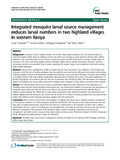Integrated mosquito larval source management reduces larval numbers in two highland villages in western Kenya

Date
2012-05-18Author
Imbahale, SS
Githeko, A
Mukabana, WR
Takken, W
Type
Journal ArticleMetadata
Show full item recordAbstract
AbstractBackgroundIn western Kenya, malaria remains one of the major health problems and its control remains an important public health measure. Malaria control is by either use of drugs to treat patients infected with malaria parasites or by controlling the vectors. Vector control may target the free living adult or aquatic (larval) stages of mosquito. The most commonly applied control strategies target indoor resting mosquitoes. However, because mosquitoes spend a considerable time in water, targeting the aquatic stages can complement well with existing adult control measures.MethodsLarval source management (LSM) of malaria vectors was examined in two villages i.e. Fort Ternan and Lunyerere, with the aim of testing strategies that can easily be accessed by the affected communities. Intervention strategies applied include environmental management through source reduction (drainage of canals, land levelling or by filling ditches with soil), habitat manipulation (by provision of shading from arrow root plant), application of Bacillus thuringiensis var israelensis (Bti) and the use of predatory fish, Gambusia affinis. The abundance of immature stages of Anopheles and Culex within intervention habitats was compared to that within non-intervention habitats.ResultsThe findings show that in Fort Ternan no significant differences were observed in the abundance of Anopheles early and late instars between intervention and non-intervention habitats. In Lunyerere, the abundance of Anopheles early instars was fifty five times more likely to be present within non-intervention habitats than in habitats under drainage. No differences in early instars abundance were observed between non-intervention and habitats applied with Bti. However, late instars had 89 % and 91 % chance of being sampled from non-intervention rather than habitats under drainage and those applied with Bti respectively.ConclusionMost of these interventions were applied in habitats that arose due to human activities. Involvement of community members in control programs would be beneficial in the long term once they understand the role they play in malaria transmission. Apart from the need for communities to be educated on their role in malaria transmission, there is a need to develop and test strategies that can easily be accessed and hence be used by the affected communities. The proposed LSM strategies target outdoor immature mosquitoes and hence can complement well with control measures that target indoor resting vectors. Therefore inclusion of LSM in Integrated Vector Management (IVM) program would be beneficial.
URI
http://dx.doi.org/10.1186/1471-2458-12-362http://erepository.uonbi.ac.ke:8080/xmlui/handle/123456789/14687
http://www.ncbi.nlm.nih.gov/pubmed/22607227
